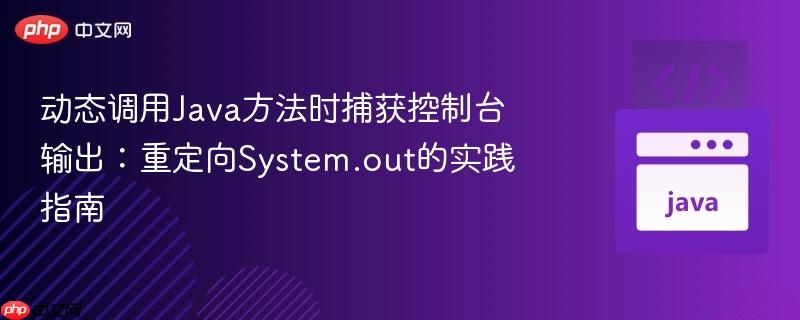
当通过`method.invoke()`调用java方法,尤其是`void`类型方法(如`main`),其返回值将为`null`,无法直接获取方法内部通过`system.out.println()`产生的控制台输出。本教程将详细介绍如何通过重定向`system.out`流,将目标方法的控制台输出捕获到字符串变量中,从而实现对动态执行代码输出的有效管理和展示。
Java反射机制中的Method.invoke()方法用于动态调用一个目标方法。其返回值行为取决于被调用方法的声明:
因此,当您尝试调用一个包含System.out.println()语句的void方法(如Java程序的main方法)时,invoke()的返回值将始终是null。这意味着您无法直接通过invoke()的返回值来获取方法内部通过System.out.println()产生的控制台输出。System.out.println()默认会将内容打印到JVM的标准输出流,也就是通常所见的控制台。
为了捕获目标方法在执行过程中产生的控制台输出,我们需要在调用目标方法之前,将System.out这个标准输出流重定向到一个自定义的输出流中。这样,所有通过System.out.println()、System.out.print()等方法输出的内容,都会被写入到我们指定的流中,而不是直接显示在控制台。在方法执行完毕后,我们可以从自定义流中提取出这些内容,并恢复原始的System.out流。
以下是实现这一策略的详细步骤和示例代码:
立即学习“Java免费学习笔记(深入)”;
import java.io.ByteArrayOutputStream;
import java.io.PrintStream;
import java.lang.reflect.InvocationTargetException;
import java.lang.reflect.Method;
import java.lang.reflect.Modifier;
// 假设这是您动态编译并加载的类
class UserProvidedCode {
public static void main(String[] args) {
System.out.println("Hello from user code!");
System.err.println("An error message from user code.");
System.out.print("Another line of output.");
}
public String calculateSum(int a, int b) {
int sum = a + b;
System.out.println("Calculating sum: " + a + " + " + b);
return "Sum is: " + sum;
}
}
public class DynamicOutputCapturer {
/**
* 捕获指定方法执行时的System.out和System.err输出。
*
* @param targetClass 目标类
* @param methodName 目标方法名
* @param paramTypes 目标方法的参数类型数组
* @param args 目标方法的参数值数组
* @return 包含标准输出和标准错误的字符串
* @throws NoSuchMethodException 如果找不到指定方法
* @throws InvocationTargetException 如果被调用的方法抛出异常
* @throws IllegalAccessException 如果无法访问指定方法
*/
public static String captureMethodOutput(Class<?> targetClass, String methodName, Class<?>[] paramTypes, Object[] args)
throws NoSuchMethodException, InvocationTargetException, IllegalAccessException {
// 保存原始的System.out和System.err流
PrintStream originalOut = System.out;
PrintStream originalErr = System.err;
// 创建用于捕获输出的字节数组输出流
ByteArrayOutputStream baosOut = new ByteArrayOutputStream();
ByteArrayOutputStream baosErr = new ByteArrayOutputStream();
// 创建新的PrintStream,将其指向字节数组输出流
PrintStream newOut = new PrintStream(baosOut, true); // true表示自动刷新
PrintStream newErr = new PrintStream(baosErr, true);
try {
// 重定向System.out和System.err
System.setOut(newOut);
System.setErr(newErr);
// 获取并调用目标方法
Method method = targetClass.getMethod(methodName, paramTypes);
Object instance = null;
// 如果方法不是静态的,需要创建类的实例
if (!Modifier.isStatic(method.getModifiers())) {
try {
instance = targetClass.newInstance(); // 尝试调用无参构造函数
} catch (InstantiationException e) {
// 如果类没有公共的无参构造函数,将无法创建实例
System.err.println("Error: Cannot create instance for non-static method. " +
"Class " + targetClass.getName() + " may lack a public no-arg constructor.");
throw new RuntimeException("Failed to instantiate class: " + targetClass.getName(), e);
}
}
// 调用目标方法
Object returnValue = method.invoke(instance, args);
// 确保所有缓冲区内容被写入
newOut.flush();
newErr.flush();
// 获取捕获到的输出内容
String capturedStandardOutput = baosOut.toString();
String capturedErrorOutput = baosErr.toString();
StringBuilder result = new StringBuilder();
if (returnValue != null) {
result.append("Method Return Value: ").append(returnValue.toString()).append("\n");
}
if (!capturedStandardOutput.isEmpty()) {
result.append("Standard Output:\n").append(capturedStandardOutput);
}
if (!capturedErrorOutput.isEmpty()) {
result.append("Error Output:\n").append(capturedErrorOutput);
}
return result.toString();
} finally {
// 恢复原始的System.out和System.err
System.setOut(originalOut);
System.setErr(originalErr);
// 关闭新的PrintStream
newOut.close();
newErr.close();
// ByteArrayOutputStream不需要手动关闭,因为它基于内存
}
}
public static void main(String[] args) {
try {
// 示例1: 调用UserProvidedCode的main方法并捕获输出
System.out.println("--- 捕获 UserProvidedCode.main() 的输出 ---");
String mainOutput = captureMethodOutput(UserProvidedCode.class, "main", new Class[]{String[].class}, new Object[]{new String[0]});
System.out.println("捕获结果:\n" + mainOutput);
// 示例2: 调用UserProvidedCode的calculateSum方法并捕获输出
System.out.println("\n--- 捕获 UserProvidedCode.calculateSum(5, 3) 的输出 ---");
String sumOutput = captureMethodOutput(UserProvidedCode.class, "calculateSum", new Class[]{int.class, int.class}, new Object[]{5, 3});
System.out.println("捕获结果:\n" + sumOutput);
// 验证原始的System.out是否已恢复
System.out.println("\n--- 原始 System.out 已恢复 ---");
System.out.println("这条消息应该正常打印到控制台。");
} catch (Exception e) {
e.printStackTrace();
}
}
}代码说明:
以上就是动态调用Java方法时捕获控制台输出:重定向System.out的实践指南的详细内容,更多请关注php中文网其它相关文章!

每个人都需要一台速度更快、更稳定的 PC。随着时间的推移,垃圾文件、旧注册表数据和不必要的后台进程会占用资源并降低性能。幸运的是,许多工具可以让 Windows 保持平稳运行。

Copyright 2014-2025 https://www.php.cn/ All Rights Reserved | php.cn | 湘ICP备2023035733号